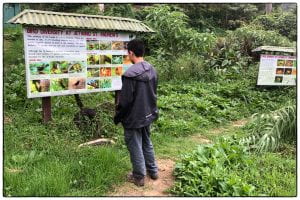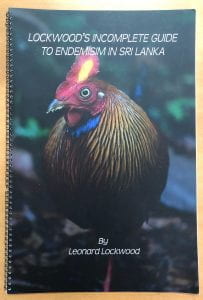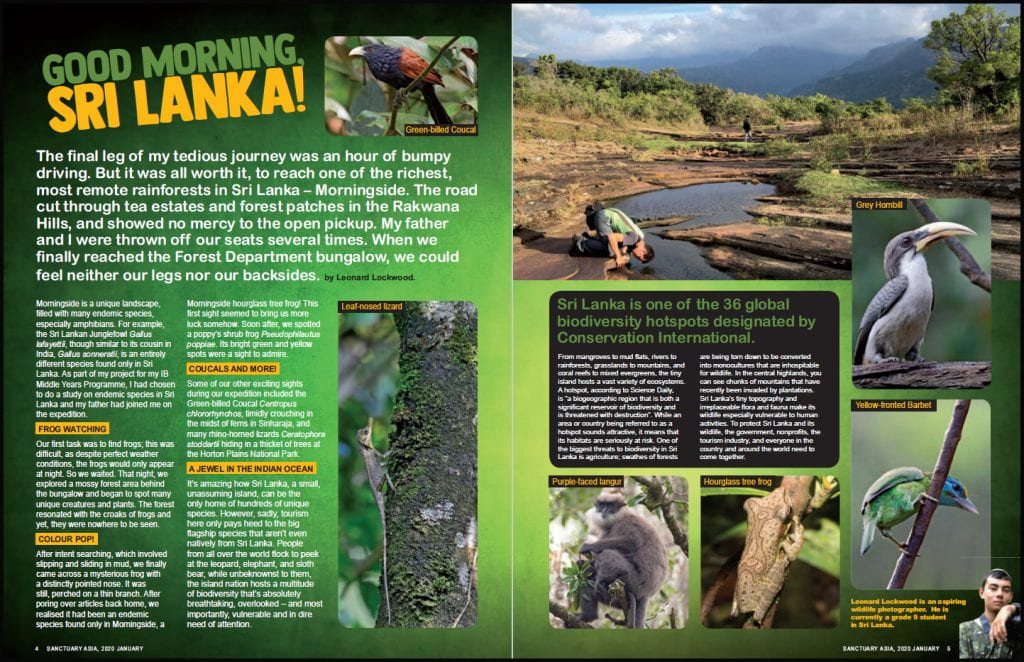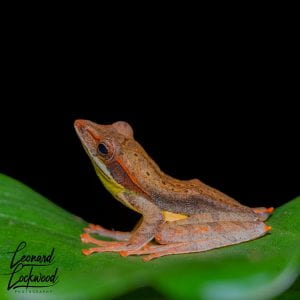A Return to Morningside

In my 17 years in Sri Lanka, I have had the opportunity to visit a special place called Morningside twice. Morningside is an isolated area only accessible through broken roads crossing remote tea plantations in the eastern part of Sinharaja Rainforest.
Now you may be wondering what makes Morningside so special? Why would my dad and I spend the time adventuring through dense, montane rainforests with barely a path ahead of us? Well, Morningside is an interesting and unique spot as because of its geographic isolation and high species diversity. It has some very rare species (point endemics) of amphibians and lizards found nowhere else. From frogs and lizards perched within the cracks of the trees to raptors soaring above us, there are lots of opportunities to observe and photograph rare biodiversity.
I first visited to Morningside when I was in 10th grade (MYP5) at OSC. We were tasked with doing a passion project of our choosing -the culminating MYP Personal Project. I chose to explore photography and the idea of endemism in Sri Lanka for my project. My goal was to record as many endemic species within Sri Lanka and create a book presenting information about each of these animals and their importance. I also submitttted an article and photo essay to the prestigious wildlife magazine Sanctuary Asia and had it published in their Cub (kids) edition In January 2020 (see this link). As part of the goal, visit places and took photographs in places where endemism is high (mainly in the Rakwana Hills, Central Highlands and Knuckles Range). Morningside was one of about five different sites that we visited looking for endemic species which we had never seen before. We spent three days there photographing as much as we could-most of it happened at night when the amphibians were active.




Now two years later my dad and I along with two friends of ours (Rashmi and Nirosha) returned to Morningside. Once again, we stayed in the small forest bungalow hidden on the edge of tea estates and the montane forest in eastern Sinharaja. This is a protected area with no signal and minimal amounts of electricity. The ride up to the house was relatively smooth which was a surprise as the last time we had done this trip, it was felt like a very bumpy rollercoaster ride. It turned out that past of the road has been improved the roads to allow for pickup trucks to be able to get to the tea plantations more smoothly. It was still an exciting ride as we had to stand while ascending the road. We were thrown around while holding on for dear life, but the scenery was gorgeous. We were able to get a great view of the rainforest covered-mountains around us. The ride took around an hour to get from the Suriyakanda road to the forest bungalow, traversing in and out of edges of jungles and tea plantations.
When we finally got to the bungalow it was mid-afternoon and we were tired from the drive from Kudawa through Rakwana to Morningside. But we were excited about what the night would bring so we quickly unloaded of our gear and supplies . No sooner had we stepped out on tot he lawn, we were greeted by multiple leeches trying to get onto our legs. This forced our team to rush the process and remove any leeches that attempted to latch on to us. We rested and waited waiting, preparing for the nigh when the amphibians would be active Soon after 6:00 our real adventure would begin. The stars came out, it got cold (we were at 1,000 meters) and pitch blackness surrounded the bungalow with the only light coming from our torches and candles.
With my leech socks strapped, camera charged, and flashes ready, we entered the rainforest in search of frogs. Deep in the forest where there was no light and only the sounds of active bugs and frogs calling, we searched up and down for unique creatures. We spent over five hours just within the jungle in hopes of finding various frogs. Our luck varied finding -some rare species hidden in a crack to accidentally falling into some thorns while photographing them. I was able to photograph several interesting and unique species of frogs, so of which we were unable to ID. This night event was our most successful outing, as we were able to find around 15 different frogs in many locations. As such we decided that the next day to go again. This time the rains were nearby and we could feel the wind creeping in, even within the dense jungle. As such, we had to cut short our adventures but were also as successful in finding unique and even endemic species of frogs. Below is a couple of my best photos from the trips. For more of my photos, you can see my link https://www.instagram.com/lockwoodphotography16/?hl=en.

Overall, I had an amazing trip returning to the place I once had been for my project. The experience of being far away from any civilization with just the animals calling around you is a beautiful feeling. To be able to photograph all these unique species is an experience I would love to do again especially in a place as amazing as Morningside.

